Articles
Feeding the Nineteenth-Century Baby:
Implications for Museum Collections
Dans le cadre de l'historiographie des dix dernières années, ce document tire des conclusions sur les différentes méthodes d'alimentation des nourrissons en Occident pour la période couvrant les années 1700 à 1900. Une histoire de ces méthodes d'alimentation doit nécessairement utiliser des sources de documentation ontariennes, à savoir des archives et des témoins matériels. Les objets étudiés et illustrés dans cette monographie proviennent du Museum of the History of Medicine à Toronto.
Les témoins matériels de ces méthodes d'alimentation des nourrissons sont particulièrement fragiles: les objets de verre cassent facilement et la période de la petite enfance ne dure pas longtemps. Au mieux, on ne tient pas compte de ces objets qui, une fois laissés de côté, sont difficiles à identifier.
Un examen de ces témoins matériels en révèle la méthode d'utilisation ainsi que les avantages, les problèmes et les difficultés probables qui leur sont liés. Ces observations peuvent servir à vérifier les hypothèses sur les conclusions à tirer des méthodes d'alimentation des nourrissons, hypothèses fondées exclusivement sur des documents d'archives.
Résumé
This paper discusses the implications inherent in different methods of infant feeding in the Western world c. 1700-1900, within the context of the historiography of the last ten years. An account of how infants were fed in the nineteenth century is interwoven with the evidence for what occurred in Ontario. This evidence is both archival and artifactual. The objects discussed and illustrated are in the collections of the Museum of the History of Medicine in Toronto.
Artifactual evidence of infant feeding practices is particularly vulnerable. Objects made of glass break easily, and infancy itself lasts only a short time. At best, the objects once abandoned are hard to recognize and therefore ignored.
An examination of the artifacts suggests their manner of use and possible difficulties, problems, or advantages associated with them. These observations can be used to test hypotheses about implications of infant feeding practices based solely on archival evidence.
1 Infant feeding is a topic that has attracted increasing interest from scholars and historians of the family and of medicine over the last ten years.1 The history and implications of infant feeding methods are strands in the growing body of work on the history of the family, which is itself a multidisciplinary study bringing together psychohistory, historical sociology and women's studies.
2 Formerly infant feeding in past times attracted little attention. Not only was breast-feeding assumed to be the norm, because how else was the infant to survive? But also mother-love for the infant was assumed to be a constant in female psychology.
3 This paper discusses the implications inherent in different methods of infant feeding in the Western world c. 1700-1900, within the context of the historiography of the last ten years. An account of how infants were fed in the nineteenth century is interwoven with evidence for what occurred in Ontario. This evidence is both archival and artifactual.
4 Interest in the special nature of childhood among historians emerges with the publication by Philippe Aries of Centuries of Childhood in 1962.2 He is not particularly interested in infant feeding practices, but his comments on the widespread practice of wet-nursing in France from c. 1700-1900 are worth noting here. He suggests that this practice originated out of maternal precaution at a time when clean milk was unobtainable and artificial feeding was awkward and dangerous, because unhygienic. This explanation is reinforced by his description of the artifactual evidence as "peculiar receptacles which are on display in the Musée de la Faculté de Pharmacie in Paris, ... must have called for considerable skill and patience."3
5 Edward Shorter is convinced that the high infant mortality rate pre-1900 in Western Europe resulted from poor infant care by "indifferent" mothers.4 He suggests that infants died, not so much from rampant infectious disease, but from unsuitable food and inappropriate care. He sees the adoption of maternal breast-feeding, starting in England in the eighteenth century among the upper class, as a sign that women were putting their infant's needs ahead of their own pleasure.
6 Lawrence Stone5 explains the changes in child-rearing practices, particularly the swing to maternal breast-feeding in England among the upper class, in terms of the changing attitudes towards children and the general development of affective relations within the family. In turn, breast-feeding itself promotes and strengthens maternal feelings.
7 The recent writings by historians and others6 focus on the implications of particular feeding practices — in particular that certain practices exemplify a lack of maternal sentiment. This suggestion that mothering is not an "eternal instinct slumbering in the female breast"7 is provocative and perhaps accounts for current interest in feeding practices.
8 The bulk of the writing on this subject, roughly pre-1960, was the work of paediatricians with an interest in the history of their special discipline.8 These writers have also shown an interest in the mechanics of infant feeding, in the material history of the subject. By contrast, the recent work of historians dwells more on the psychological implications of different methods and sets these feeding practices into their wider social, economic and cultural context.
9 Infant feeding practices are literally a matter of life and death, and this was particularly clear in the nineteenth century. In this section I outline the development of infant feeding as practised in the United States and Britain, matched against a picture of Canadian practice.
10 By 1800 it was generally accepted by doctors that, based on empirical evidence, babies fared best when breast-fed by their mothers. Fairly sophisticated manuals were written for mothers.9 The upper classes in post-Rousseauian Europe were receptive to these medical ideas with the result that maternal breast-feeding became fashionable (fig. 1).
11 The alternatives to maternal breast-feeding were wet-nursing, either in or outside the home, or artificial feeding. Alternatives existed because some mothers have always been unwilling or unable to breast-feed their infants. Some were unwilling for reasons of fashion, such as a fear their breasts would become misshapen and their beauty would be lost. At an earlier period there were ideas, based on the current understanding of the physiology of lactation, that sexual intercourse harmed the milk. It was also believed that colostrum, the fluid secreted in the first days after childbirth, was harmful to the baby and therefore maternal feeding should wait for about eight days, until the lying-in period was over.10
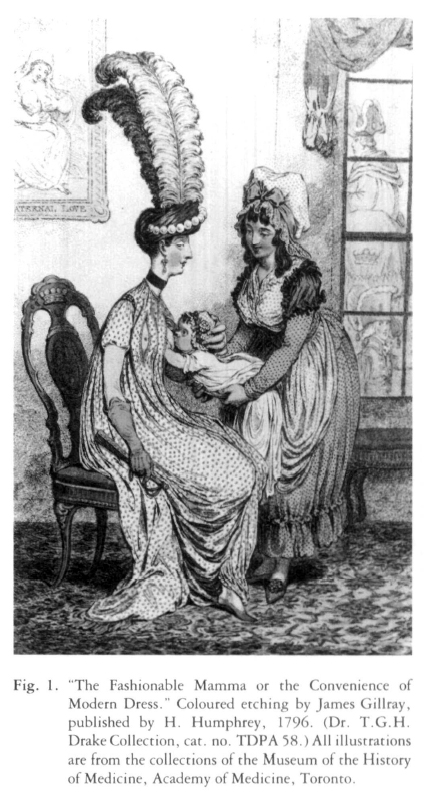 Display large image of Figure 1
Display large image of Figure 112 Mothers were unable to feed their babies if they had died in childbirth, or if they were ill or were badly nourished themselves (fig. 2). Ante-natal care was nonexistent for most women in the nineteenth century. However, doctors were beginning to be aware of the effects of maternal health. By 1896 A. Jacobi, the American paediatrician, writes "Mothers who suffered much during their pregnancies, or were delicate themselves, are liable to give birth to anaemic and puny infants."11
13 Pap or panada was the food most commonly fed to even newborn babies who required alternative feedings, from a pap boat or spoon. These vessels were made in most materials, e.g., pewter, porcelain and earthenware (fig. 3).
14 Pap was a flour mixture or bread cooked with water, with occasional additions of wine or beer and sweeteners. Milk was sometimes added to pap, or used on its own in "bottles." However, animal milks were regarded with some caution because it was believed that the baby imbibed aspects of the animal's (or indeed the wet-nurse's) temperament or character with the milk. Goats were "frisky" and red-headed wet-nurses possessed undesirable moral characteristics.
15 Pap was dangerous food because it was nutritionally inadequate, and it was often prepared with unclean ingredients. (The cleanliness of milk and water supplies was uncertain until the twentieth century.) Moreover, pap was kept warm for long periods of time in a ceramic food warmer in conditions ideal for the growth of bacteria.
16 Physicians were aware that artificial hand-feeding was associated with death and disease. William Buchan points out that "children may seem to thrive for a few months without the breast; but when teething, the small-pox, and other diseases incident to childhood, come on they generally perish."12 Teething is mentioned in this context because it coincides with weaning and thus coincides with illness often resulting from unclean food (gastroenteritis) or from lack of necessary vitamins in the food (scurvy).
17 Infant feeding in Upper Canada followed the pattern established in England. Elizabeth Simcoe, the wife of the first lieutenant-governor, living in a sparsely populated area, notes in 1791-96 that she is breast-feeding her infant and "I hope she will not feel the want of a wetnursc, which was what I could not secure for her."13 Linda Siegel, in her paper, "Child Health and Development in English Canada, 1790-1850,"14 suggests that Mrs. Simcoe's worry was not so much her inability to obtain a wet-nurse (servants were notoriously scarce at this period) but a real fear that she might have insufficient milk for her baby. Siegel examines the writings of two other women, Mary O'Brien and Letitia Hargrave for the period 1828-52 and concludes that both basically breast-fed their babies, using a wet-nurse when unable to feed the baby and using a bottle for supplementary feedings. She notes that a fear of having insufficient milk is implied, a fear still common among new mothers. References to wet-nurses occur in other Canadian writings of this period. Anne Langton writes in 1846 of a baby whose mother died in childbirth that "My mother paid for a six-months' nursing-out of the little delicate baby, and it is now a thriving healthy child."15
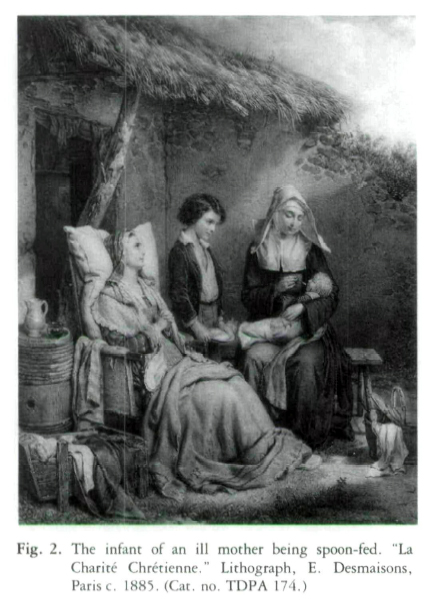 Display large image of Figure 2
Display large image of Figure 2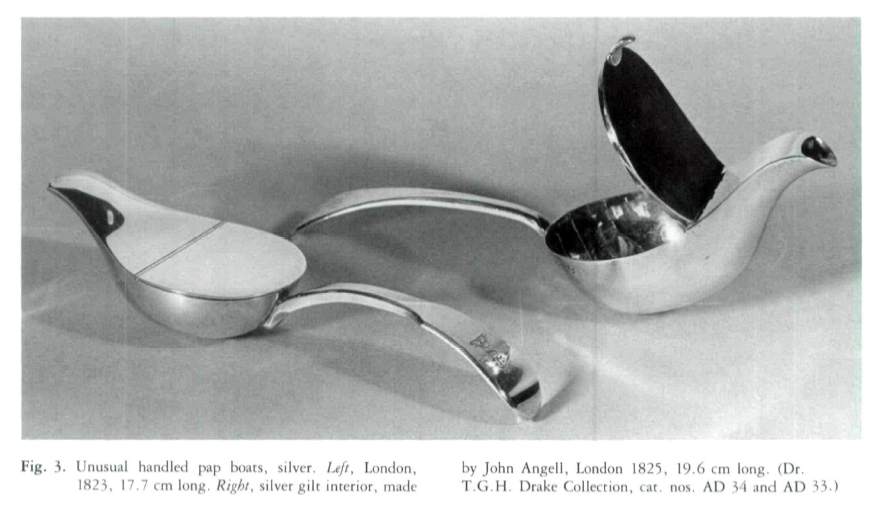 Display large image of Figure 3
Display large image of Figure 318 The artifactual evidence for breast-feeding is the existence of objects designed to cope with its inconvenience, that is, nipple shields, nipple shells and breast pumps. These are objects which, by their very nature, are vulnerable to destruction and lack of recognition. Nipple shields were designed for the prevention and care of cracked nipples, and for the attachment of an artificial nipple which the baby sucked. T.G.H. Drake remarks that "wood and lead shields have not been preserved on account of their low intrinsic value."16 However, interestingly enough, it is wooden examples used in Ontario that are in the collection of the Museum of the History of Medicine, Toronto (fig. 4).
19 Nipple shells (fig. 4) are round glass receptacles, again their use is not readily deduced from their form. They were used to catch milk leaking from the breasts between or just before a feeding so that the mother's clothing stayed dry. The early breast pump in the collection, of handblown glass, would be used to draw out retracted nipples or draw off milk from congested breasts (fig. 4).
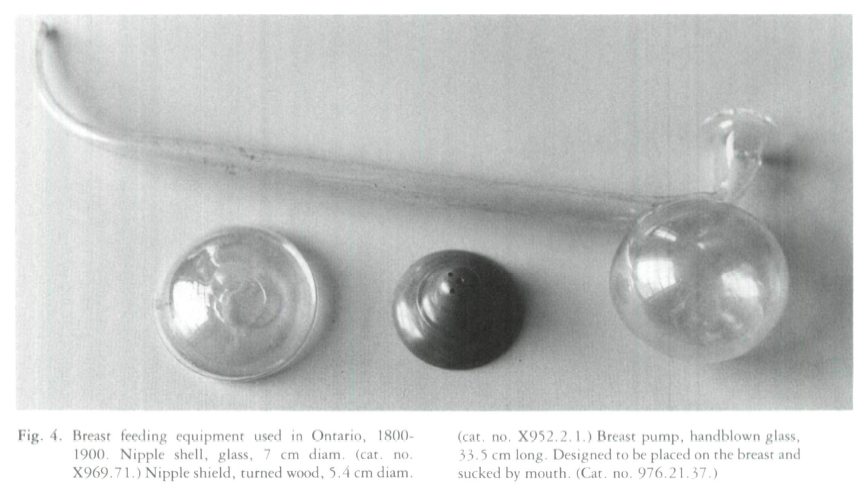 Display large image of Figure 4
Display large image of Figure 4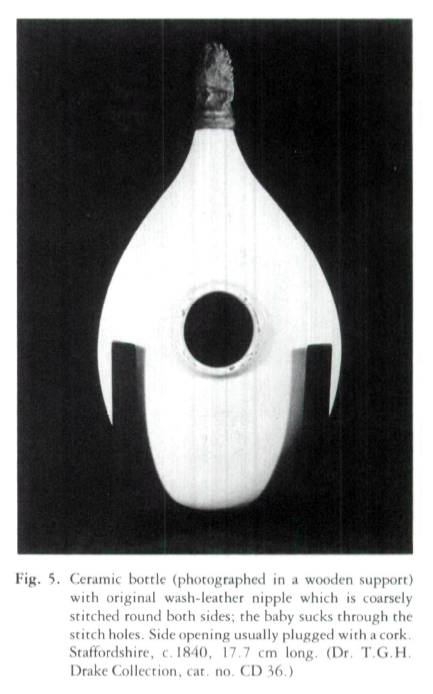 Display large image of Figure 5
Display large image of Figure 520 The artifactual evidence for artificial feeding in the pre-1850 period in Ontario is non-existent, based on the Museum's collections. Whereas in the Drake collection, there exists abundant evidence for this practice from most European and some Asian countries from the ancient world to the nineteenth century. However, there is some literary evidence. Mary O'Brien'17 writing in Ontario 1828-38 used supplementary feedings: "Was preparing the bottle for baby (I am obliged sometimes to have recourse to it)." The bottle she would have used was probably of the submarine-shaped earthenware variety. It was designed to be plugged with a cork and fitted with a nipple made of chamois or parchment, stuffed with sponge or a rag to prevent it collapsing inwards. The baby sucked through the stitch holes (fig. 5).
21 Baby's bottles, along with items such as toothbrushes, invalid feeders, medicine spoons and eye baths were part of the apothecary's counter lines. These "sundries," together with the sale of proprietary medicines, helped supplement the business of dispensing drugs.
22 By the beginning of the nineteenth century the idea that a bottle was better than a spoon for feeding a baby had caught on. Dr. Hugh Smith describes a spouted feeding pot he designed: "The child is equally satisfied as it would be with the breast; he is obliged to labour for every drop he receives in the same manner as when at the breast; and, greatly in recommendation of this contrivance, the nurses confess it saves a great deal of trouble in the feeding of an infant"18 (fig. 6).
23 It was believed that sucking the food caused it to be mixed with the saliva in the mouth before being swallowed; sucking also restricted the amount of food taken at a time, thus reducing the infant's chances of over-distending its stomach.
24 The mixture in the bottle was usually sweetened cow's milk (the most readily obtainable milk), which was replacing "the vile compounds of flour and milk, bread and water, or oatmeal and water, large quantities of which under the names of pap, panada, and water-gruel, were until a very late period forced down an infant's throat."19
25 Mothers appear always to have needed and sought after alternative methods of infant feeding. And in the second half of the nineteenth century technological and scientific developments helped by leading the way to the safer artificial feeding methods of the twentieth century.
26 Ironically, however, the technological innovations of mid-century, rubber nipples and canned and dehydrated infant foods, which offered greater ease of administration for the mother, temporarily increased the hazards for the baby. The rubber nipple, patented by Elijah Pratt in 1845 in the United States freed the mother from the nuisance of sewing chamois leather teats, or preparing calfs teats in spirit, or even decalcifying ivory to render it soft. However, because this invention predated germ theories of disease, mothers used it freely, not knowing that nipples had to be sterilized to prevent them from passing harmful bacteria on to the baby.
27 The canned and dried infant foods, a product of the developing prepared-food industry, were heavily advertised to both mothers and doctors20 in newspapers, magazines and medical journals. These foods, which were easily fed to babies with the new rubber nipples, were dangerous on two counts. One, these patent or proprietary infant foods when used as the sole infant food were nutritionally inadequate. Two, the lack of clean milk and water supplies ensured that harmful microorganisms would be passed on if present.
28 Job Lewis Smith, a founder of paediatics in America, was pessimistic about artificial feeding. He wrote in 1872 "In the large cities, if I may judge from our New York experience, this mode of alimentation, for young infants should always be discouraged. It generally ends in death, preceded by evidences of faulty nutrition."21 Contemporary opinion was unclear why, but knew empirically that artificial feeding often resulted in death. (The sciences of bacteriology and nutrition were just developing at mid-century.)
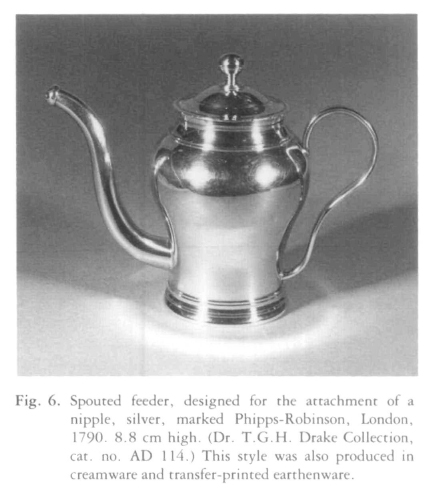 Display large image of Figure 6
Display large image of Figure 629 The chemistry of milk was first mentioned by Michael Underwood in 179922 and illustrated by two inaccurate tables comparing the composition of human, cow's, goat's, ass's and mare's milk. In the nineteenth century the composition of milk became known with the alliance of chemistry and microscopy. Philippe Biedert in 1869 developed the idea of a "formula" (note the scientific word)23 for altering cow's milk so that it most closely resembled human milk. These formulae could be extremely complex based as they were on the individual baby's need, requiring a doctor to prescribe them and a considerable period of time to prepare them.24 Although by about 1890 doctors understood that babies needed a certain number of calories in proportion to their weight and although they knew how to adjust amounts of protein, fat and sugar to approximate human milk, they did not know why bottle-fed babies frequently suffered from anaemia and infantile scurvy. Vitamins were beginning to be identified; vitamin C, the anti-scorbutic known empirically since 1753, was isolated in 1928. This realization of the problem without understanding its cause resulted in patent infant foods, per se, being blamed for these deficiency diseases rather than the absence of particular substances.
30 Bacteriology, through the work of Pasteur and Koch, explained the role of microorganisms in producing disease. By the 1880-1900 period the significance of bacterial action was appreciated by the food, agriculture and dairying industries. Milk was first commercially pasteurized in Denmark in 1890 to prevent it going sour on the train journey from farm to city. And by 1896 it was realized that this treatment gave protection against milk-borne diseases.25
31 Infant feeding in Ontario (as it was known after 1867), as far as one can tell, followed the American pattern.26 The mortality figures for infants were high; cities such as Toronto were rapidly industrializing and sanitary conditions for the poor were appalling.27 The mortality rates for Toronto in 1890 are very detailed, giving an age and a disease breakdown. Although retrospective diagnosis is notoriously difficult, based on a conservative judgement, it is estimated that some 58 per cent of the 1,207 infants under the age of twelve months who died, did so from feeding-related disease.29 Infant deaths made up a third of all deaths in Toronto in that year.
 Display large image of Figure 7
Display large image of Figure 732 Babies were fed with glass bottles, first submarine-shaped ones styled after the ceramic bottles from earlier in the century and later upright, mass-produced bottles (fig. 7). Only two Ontario bottles exist in the Museum's collection, reflecting the fragility of such artifacts, the lack of importance given to infancy, which is after all only a short period in life, and possibly the fact that not many were in circulation. Chavasse's insistence "I say bottles, for there ought to be at least two — must be kept beautifully clean,"30 suggests that mothers usually only bought the one.
33 Patent foods were also widely used. Dr. Blackader writing in 1884, though probably about Montréal, says "of the milk foods Nestles' and Gerbers' are probably most used. Of those prepared from Liebig's formula, Mellin's is undoubtedly the best; and I have occasionally prescribed it with good results."31 Justus von Liebig, the German chemist classified organic foodstuffs and in 1867 devised and patented a food advertised as "the most perfect substitute for mother's milk." It was the first of an endless variety of infant foods, composed of dried milk, cereal and a malt preparation. Mellin's food is one of twelve varieties of patent infant foods in the Museum collection.32
34 The foods divide into three groups based on their contents: dried cow's milk with some ceteal and sugar (Nestles Food, Horlick's); a malted preparation (Mellin's); pure cereal to be used with fresh cow's milk (Eskay's Food, Imperial Granum). They owe their popularity to their ease of preparation, "just mix a large teaspoonful of the Patent Food with a little cold water or milk..." (Dr. Ridge's Food) and the medical and scientific seal of approval with which they were advertised (fig. 8). Mincasea claimed to "transform cow's milk into healthy Breast Milk for the successful rearing of Infants as recommended at the Meeting of the Harveian Society and Medical Society by Drs. Routh, Lobb, Brooke and numerous obstetricians." Mothers now found themselves the target of a flourishing advertising industry assisted by doctors themselves. Physicians were increasingly involved in giving advice on infant feeding, a difficult position to be in when there was an absence of unanimity about the best method.
35 A most valuable document, in that it gives examples of all possible methods of infant feeding at the end of the century, is a notebook kept by a public health nurse in Toronto, 1898-1899.33 One of the possible sites for childbirth was the maternity boarding house. The users of these lying-in homes were unmarried women, equally divided between working women in the city and women from outlying villages. Toronto required these homes to be licensed and inspected and to retain the services of a medical practitioner. These reports are invaluable for the word of mouth testimony they provide from the women who answered the nurse's questions. Of the ten women who gave complete answers to the set of questions, three answered that they were breast-feeding or would breast-feed their babies, including one woman who ultimately planned to place her child with the Children's Aid Society. One unmarried woman stated that the baby's father would adopt the baby and hire a wet-nurse for it. Six women were or had been bottle-feeding their infants.
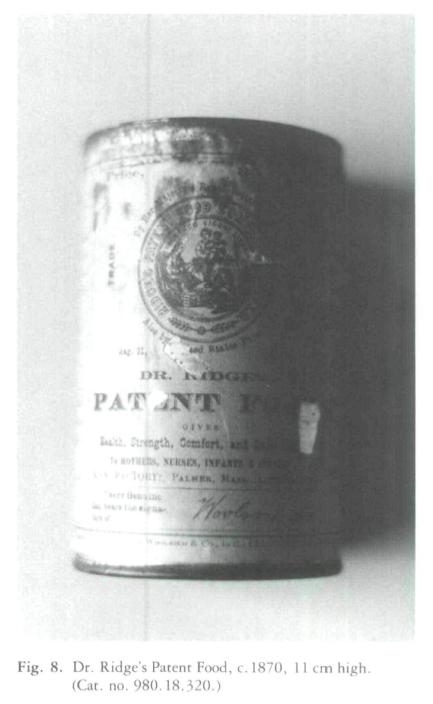 Display large image of Figure 8
Display large image of Figure 836 The bottle in figure 9 is typical of those used in the late nineteenth century. Two of the infants in this group had died, one, who had been fed on milk and barley water, of "summer colic" and one, who had been born ten days earlier weighing ten pounds, "of nothing in particular." Of the mothers with living infants, one was using "Nestles milk food" and another "canned food" which drew this comment on the infant from the nurse — "does not look thriving."
 Display large image of Figure 9
Display large image of Figure 937 In summary, this paper describes the research relationship between objects and archival material.
38 An examination of objects, even if only a visual examination by a museum visitor, can suggest the kinds of skills needed to use the object, or the problems and difficulties that might be encountered in its use. This is particularly apparent when looking at the breast-feeding equipment illustrated earlier in this paper.
39 Museum collections of artifacts and graphic material relating to infant feeding function, as do all material history collections, as evidence of past practices. The collections are the link between archival evidence and the imagination and occasionally the only evidence of past practice. Observations resulting from a careful and critical examination of objects can be used to test hypotheses based on the archival evidence, which is the type most commonly used by non-museum historians.